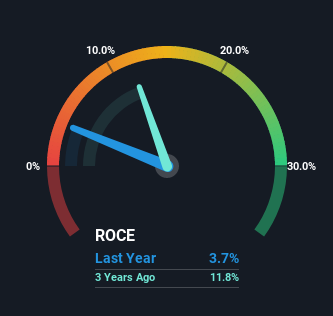- Hong Kong
- /
- Infrastructure
- /
- SEHK:357
Some Investors May Be Worried About Hainan Meilan International Airport's (HKG:357) Returns On Capital

If you're looking at a mature business that's past the growth phase, what are some of the underlying trends that pop up? Typically, we'll see the trend of both return on capital employed (ROCE) declining and this usually coincides with a decreasing amount of capital employed. This indicates the company is producing less profit from its investments and its total assets are decreasing. So after we looked into Hainan Meilan International Airport (HKG:357), the trends above didn't look too great.
Return On Capital Employed (ROCE): What Is It?
If you haven't worked with ROCE before, it measures the 'return' (pre-tax profit) a company generates from capital employed in its business. Analysts use this formula to calculate it for Hainan Meilan International Airport:
Return on Capital Employed = Earnings Before Interest and Tax (EBIT) ÷ (Total Assets - Current Liabilities)
0.037 = CN¥175m ÷ (CN¥11b - CN¥6.1b) (Based on the trailing twelve months to June 2022).
So, Hainan Meilan International Airport has an ROCE of 3.7%. In absolute terms, that's a low return and it also under-performs the Infrastructure industry average of 5.5%.
Check out our latest analysis for Hainan Meilan International Airport

In the above chart we have measured Hainan Meilan International Airport's prior ROCE against its prior performance, but the future is arguably more important. If you're interested, you can view the analysts predictions in our free report on analyst forecasts for the company.
What Does the ROCE Trend For Hainan Meilan International Airport Tell Us?
In terms of Hainan Meilan International Airport's historical ROCE trend, it isn't fantastic. The company used to generate 9.5% on its capital five years ago but it has since fallen noticeably. On top of that, the business is utilizing 36% less capital within its operations. The fact that both are shrinking is an indication that the business is going through some tough times. Typically businesses that exhibit these characteristics aren't the ones that tend to multiply over the long term, because statistically speaking, they've already gone through the growth phase of their life cycle.
On a side note, Hainan Meilan International Airport's current liabilities have increased over the last five years to 56% of total assets, effectively distorting the ROCE to some degree. If current liabilities hadn't increased as much as they did, the ROCE could actually be even lower. And with current liabilities at these levels, suppliers or short-term creditors are effectively funding a large part of the business, which can introduce some risks.
In Conclusion...
To see Hainan Meilan International Airport reducing the capital employed in the business in tandem with diminishing returns, is concerning. Yet despite these concerning fundamentals, the stock has performed strongly with a 89% return over the last five years, so investors appear very optimistic. Regardless, we don't feel too comfortable with the fundamentals so we'd be steering clear of this stock for now.
On a separate note, we've found 1 warning sign for Hainan Meilan International Airport you'll probably want to know about.
For those who like to invest in solid companies, check out this free list of companies with solid balance sheets and high returns on equity.
If you're looking to trade Hainan Meilan International Airport, open an account with the lowest-cost platform trusted by professionals, Interactive Brokers.
With clients in over 200 countries and territories, and access to 160 markets, IBKR lets you trade stocks, options, futures, forex, bonds and funds from a single integrated account.
Enjoy no hidden fees, no account minimums, and FX conversion rates as low as 0.03%, far better than what most brokers offer.
Sponsored ContentValuation is complex, but we're here to simplify it.
Discover if Hainan Meilan International Airport might be undervalued or overvalued with our detailed analysis, featuring fair value estimates, potential risks, dividends, insider trades, and its financial condition.
Access Free AnalysisHave feedback on this article? Concerned about the content? Get in touch with us directly. Alternatively, email editorial-team (at) simplywallst.com.
This article by Simply Wall St is general in nature. We provide commentary based on historical data and analyst forecasts only using an unbiased methodology and our articles are not intended to be financial advice. It does not constitute a recommendation to buy or sell any stock, and does not take account of your objectives, or your financial situation. We aim to bring you long-term focused analysis driven by fundamental data. Note that our analysis may not factor in the latest price-sensitive company announcements or qualitative material. Simply Wall St has no position in any stocks mentioned.
About SEHK:357
Hainan Meilan International Airport
Engages in the aeronautical and non-aeronautical businesses at the Haikou Meilan Airport in the People's Republic of China.
Reasonable growth potential and fair value.
Market Insights
Community Narratives




